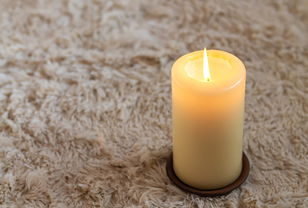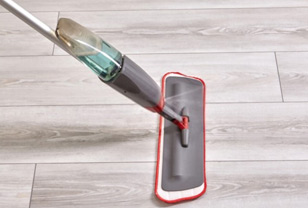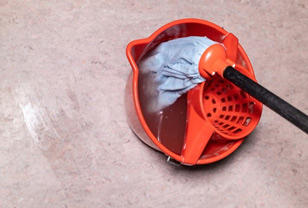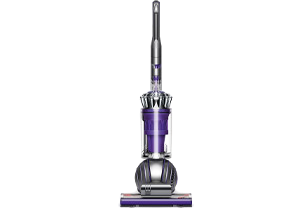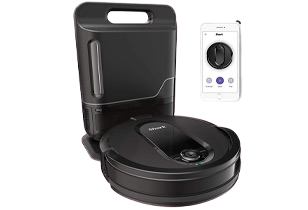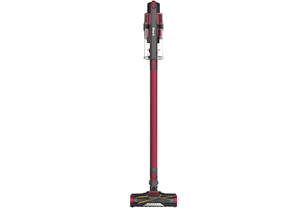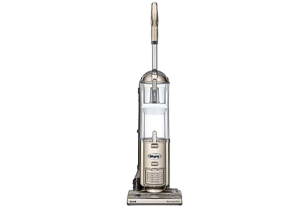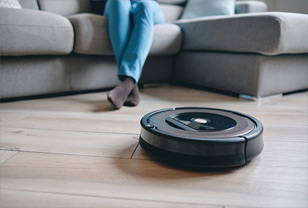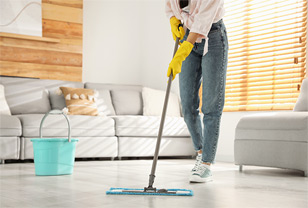How to Get Mold Out of Clothes: Save Your Wardrobe and Stop Musty Smells
Everything here is written for real life: small apartments, high humidity, busy schedules, shared laundry rooms, and a mix of cheap basics and favorite pieces you really don’t want to lose. Treat it like a practical handbook and turn the key parts into a checklist you keep near your washing machine.
This guide focuses on everyday mold on clothing and doesn’t replace medical advice or professional mold remediation after flooding or large, structural mold problems.
1. How to Get Mold Out of Clothes: Step-by-Step Method
Most people notice mold on clothing at the worst possible moment – just before work, a trip, or an event. Instead of guessing or hoping the smell disappears in a single wash, follow this simple routine that works for most everyday moldy laundry.
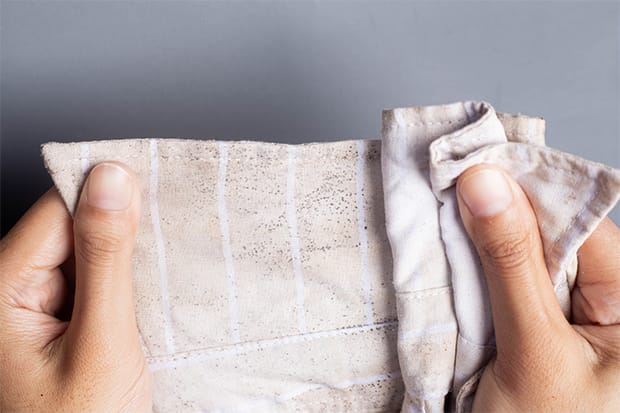
Mold can ruin your clothes and pose health risks, especially if you’re allergic to mold
1.1. Quick Answer: The 7-Step Mold-Removal Checklist
If you only have a few minutes and want the short version, start here. These steps cover the basic process for how to get mold out of clothes:
- Isolate moldy items so they don’t touch clean clothes.
- Work safely: wear gloves and a mask, and open windows or work outside.
- Shake off loose mold outdoors to keep spores out of your home.
- Soak in a vinegar solution (equal parts white vinegar and cool water) for 1–several hours.
- Gently scrub stains with a soft brush, especially along seams and folds.
- Rinse well, then dry in sunlight if the care label allows it.
- Wash as usual with laundry detergent and check again before storing.
If stains or odors remain, repeat the process and add baking soda, hydrogen peroxide (for whites only), or a fabric-safe mold remover. The next section is the full version when you have more time.

You need to gather some necessary materials before putting your hands on removing mold on clothes
1.2. Detailed Steps: From Isolation to the Final Wash
This is the main routine you’ll use to clean mold off clothes without spreading spores or damaging fabrics.
Step 1: Isolate moldy garments
Find every item that looks or smells moldy. Keep them in a separate basket or bag so growth doesn’t spread to clean laundry or your closet.
Step 2: Do safety checks before cleaning
Removing mold can release spores into the air. To reduce your exposure:
-
Wear gloves, a mask, and eye protection.
-
Work in a well-ventilated area with windows open.
-
If possible, do the first steps outdoors.
Step 3: Shake off loose mold (outdoors)
Take each affected piece outside and gently shake or brush off loose growth. This cuts down the number of spores inside your home and makes later cleaning more effective.
Step 4: Mix a vinegar solution
In a basin or sink, mix equal parts white vinegar and cool water. Vinegar’s mild acidity helps break down mold and loosen its grip on fabric without harsh chemicals, and it’s a popular choice because it’s effective, affordable, and gentle on most everyday textiles.
Step 5: Soak and gently scrub
-
Submerge the moldy clothing in the solution.
-
Soak for about 1 hour for light mold; leave several hours or overnight for heavier growth.
-
After soaking, use a soft brush to gently scrub stained areas, especially around seams, folds, and collars.
Always spot-test vinegar or any cleaner on a hidden area first, especially with bright colors or delicate fabrics. If the fabric discolors or feels rough after drying, switch to a gentler method or a professional cleaner.
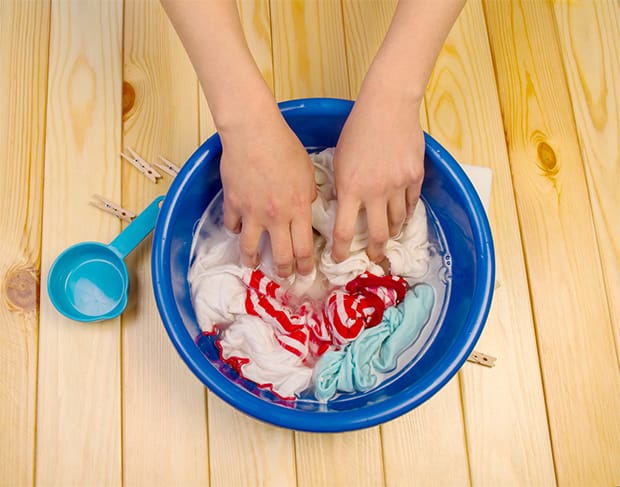
Soak affected clothing in the mixture of vinegar and water for an hour or longer to remove stubborn mold
Step 6: Rinse thoroughly
Rinse the clothing under cool running water. If you still see visible patches, repeat the soak-and-scrub routine on those spots until they fade or stop improving.
Step 7: Use sunlight when you can
Hang the rinsed clothes outside in direct sunlight if your fabric care label allows it. Sunlight helps dry fabric quickly and works like a mild, natural disinfectant. If you don’t have outdoor space, hang items in a bright, well-ventilated room and use a fan.

Sunlight is the “hero” to keep mold away from your garments
Step 8: Wash and sanitize as usual
Wash the garments with your regular detergent. Use the warmest cycle that’s safe for the fabric to help reduce mold spores in the wash. After washing, check each piece again before returning it to your closet or drawers.
In simple laundry tests at home, a cotton T-shirt with week-old mold spots usually cleaned up after two soak-and-scrub cycles plus a warm-water wash. A delicate silk blouse with similar growth, however, went straight to a professional cleaner instead of home treatment. Use the same logic at home: the more delicate or valuable the piece, the more cautious you should be.
2. Why Mold Grows on Clothes and Why Acting Fast Matters
Knowing why mold grows on clothes makes it much easier to plan how to get mold out of clothes and stop the problem from coming back. Mold thrives in moisture, warmth, and still air, so clothes that sit damp in a bag, on the floor, or in a packed wardrobe give it almost perfect conditions.
2.1. Early Signs of Moldy Clothes and Hidden Damage
Mold on clothing usually shows up as fuzzy or powdery patches in green, gray, black, or dark brown. Sometimes it’s obvious; other times you only notice:
-
A faint ring around seams or pockets.
-
Tiny dots along collars, cuffs, or waistbands.
-
A stubborn, basement-like smell that doesn’t disappear after washing and air drying.
Over time, mold can:
-
Weaken fabric fibers and create thin spots or holes.
-
Make garments lose their shape and feel rough or scratchy.
-
Spread quietly to nearby items in your wardrobe or laundry basket.
Catching growth early makes removing mold from clothing much easier and gives you a better chance of saving the fabric instead of throwing it away.
2.2. How Mold on Clothes Affects Your Health and Home
Moldy clothes aren’t just a cosmetic issue. Mold spores can:
-
Trigger sneezing, coughing, and nasal congestion.
-
Cause itchy eyes or skin irritation.
-
Worsen symptoms if you have asthma, allergies, or a sensitive respiratory system.
Black mold stains and persistent mildew smells are clear signs spores have been sitting in the fabric for a while and need real cleaning, not just perfume or fabric spray.
If several loads come out of the washer smelling musty, part of the problem may be inside your washing machine. Mold and biofilm can build up in rubber gaskets, detergent drawers, and drums, especially on front-load models. Running a machine-cleaning cycle, wiping seals dry, and leaving the door slightly open between washes all help protect both your laundry and indoor air quality.
For persistent breathing problems, skin reactions, or signs of large-scale mold in your home, this guide shouldn’t replace medical advice or professional remediation. Talk to a healthcare provider and consider calling a mold specialist if you’re worried about your overall exposure.
2.3. Your Simple “Mold Kit”: Tools and Products That Actually Help
A small “mold kit” lets you act quickly instead of postponing the problem.
Useful items:
-
Rubber gloves and a face mask or respirator.
-
Protective eyewear if you’re working with splashing solutions.
-
Plastic bags to isolate moldy clothing.
-
White vinegar for mold and mildew removal.
-
Baking soda for odor control and mild scrubbing.
-
Laundry detergent that suits your fabrics.
-
A soft brush (for example, an old toothbrush).
-
A plastic basin or sink for soaking.
Keep them together in a box or caddy so you’re always ready when you spot moldy laundry.
3. Advanced Fixes for Stubborn Mold Stains and Lingering Odors
Sometimes the basic steps aren’t enough. Deep stains and stubborn odors need more focused treatment. This is where advanced methods, how to get mildew smell out of clothes that still stink after washing, and how to get mold out of clothes without bleach become useful.
3.1. Deep Treatment for Embedded Mold on Clothes
Mold can penetrate further into the fibers after sitting for several days or weeks.
-
Check the fabric under good light. If you see deep stains, thinning areas, or holes, the item may already be too weak for aggressive treatment.
-
Use a fabric-safe mold and mildew remover, following the label for dilution and dwell time.
-
Gently scrub with a soft brush; avoid aggressive scrubbing on delicate materials.
-
Rinse thoroughly and repeat once or twice if needed until stains fade as much as they reasonably can.
-
Dry completely in the sun or in a warm, dry area with strong airflow. Never put a still-damp garment straight back into a drawer or closet.
3.2. How to Get Mildew Smell Out of Clothes That Still Stink After Washing
Sometimes clothes look clean but still carry a stale, moldy scent, especially in thick areas like waistbands, underarms, and towel loops.
Try this mildew-odor routine:
-
Pour one cup of white vinegar into a basin filled with cool water.
-
Add ½ cup of baking soda and stir.
-
Soak the garments for 1–2 hours.
-
Gently squeeze the fabric so the solution moves through bulky areas.
-
Rinse well, then wash as usual.
-
Dry fully in sunlight or a warm, well-ventilated space.
If odors persist, repeat the soak or add a laundry booster designed for musty smells. The real difference comes from combining odor-neutralizing ingredients with thorough drying and good airflow.
3.3. How to Get Mold Out of Clothes Without Bleach
If you want to avoid bleach, you still have strong options for treating moldy garments:
-
Vinegar soaks (the core method above).
-
Baking soda paste on small mold spots before washing.
-
Hydrogen peroxide on white, bleach-safe fabrics (spot-test first).
-
Lemon juice and sun for mild stains on light fabrics.
-
Tea tree oil spray in small amounts, tested on a hidden area first.
-
Non-chlorine, fabric-safe commercial mold removers.
You may need more than one round of treatment, but colors and delicate fibers usually stay safer than they would with chlorine bleach.
3.4. Common Mistakes That Make Mold Worse
Avoid these habits if you want better results:
-
Putting moldy clothes straight into the dryer – heat can set stains and odors more deeply.
-
Using bleach on colored or delicate fabrics without testing – this often leads to fading, yellowing, or damage.
-
Scrubbing fragile fabrics too hard and creating thin spots or holes.
-
Cleaning without gloves and a mask in small, closed rooms.
-
Storing “almost dry” clothes in dark drawers or closets where moisture stays trapped.
4. Daily Habits to Prevent Moldy, Musty-Smelling Clothes
Preventing mold is much easier than rescuing a whole load of ruined laundry. A few simple habits can keep your wardrobe fresher, even in humid climates or small apartments.
4.1. Improve Airflow and Control Moisture
-
Don’t pack clothes too tightly in closets; leave small gaps so air can move.
-
Open closet doors regularly to let fresh air in.
-
Use dehumidifiers, moisture absorbers, or silica gel packs in damp storage areas.
-
Keep hampers and baskets away from wet bathroom walls or damp corners.
4.2. Store Clothes Smartly, Especially Seasonal Items
-
Never put slightly damp clothes back in drawers or closets — including gym wear, towels, jeans, and thick fabrics.
-
Use airtight bins or vacuum-seal bags for long-term storage.
-
Add moisture absorbers if you store clothes in lofts, basements, or garages.
-
Avoid storing garments directly against exterior walls or next to areas with condensation.
4.3. Build Better Laundry Routines
-
Remove clothes from the washer as soon as the cycle finishes.
-
Hang sweaty gym gear or damp towels to dry before placing them in a hamper.
-
Clean your washing machine regularly with a drum-clean cycle or a vinegar-and-hot-water wash (if your manual allows it).
-
Do quick smell and visual checks in your closet every few weeks so you can catch early signs of mold.
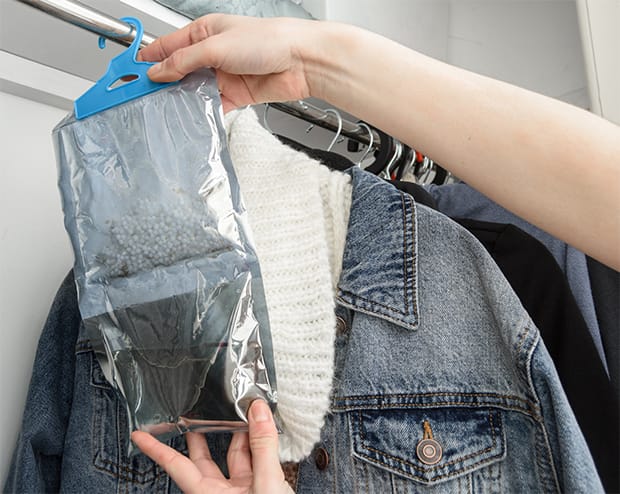
Hanging moisture-absorbing packets in the wardrobe is an easy way to prevent mold
5. Fabric-Safe Methods at a Glance
Match your cleaning approach to what your clothes are made of, so you remove mold without ruining the garment.
Cotton and linen
Usually safe with vinegar soaks, baking soda, sunlight, and gentle scrubbing. Avoid extreme heat and overly harsh rubbing that can shrink or roughen fibers.
Polyester and synthetics
Handle vinegar and baking soda well and tend to dry quickly. Check care labels before using high heat or strong commercial cleaners.
Wool, silk, and delicate blends
Very sensitive to soaking, heat, and strong chemicals. Use short, gentle treatments and consider professional cleaning for heavy mold or luxury pieces.
Denim and thick fabrics
Often tolerate longer soaks and more scrubbing. Always test for colorfastness first and focus on waistbands, cuffs, and seams where mold and odor like to hide.
6. When to Let Go: Clothes You Shouldn’t Keep
Sometimes the safest and most realistic choice is to say goodbye to a garment.
Consider throwing an item away if:
-
Mold covers large areas or forms thick, fuzzy layers.
-
There are deep stains plus thinning fabric or visible holes.
-
The garment has been stored damp and moldy for months or after flooding.
-
Someone in your home has severe mold allergies, asthma, or a weakened immune system.
Letting one unsafe piece go can still protect the rest of your wardrobe and reduce the overall mold load in your home. If mold on clothing is part of a bigger problem — like growth on walls, ceilings, or carpets — it’s time to call a professional mold remediation service instead of handling everything alone.
7. Key Takeaways and Practical Next Steps
By now, you know how to get mold out of clothes at home without guesswork. With a few basic supplies, a safe work setup, and a clear routine, you can rescue many pieces you might’ve been ready to throw out.
Remember:
-
Act quickly when you see spots or smell a musty odor.
-
Start with safe basics: vinegar, baking soda, airflow, and sunlight.
-
Use stronger products only when you really need them.
-
Always dry everything completely and manage moisture and humidity.
-
Clean your washing machine and storage areas if mold keeps returning.
Turn this into a simple “mold emergency” checklist you keep near your laundry area so you don’t have to search for instructions next time. If this guide helps, share it with someone else dealing with moldy laundry – it might save a pile of clothes and help TheKingLive keep offering tested, real-world home care advice.
FREQUENTLY ASKED QUESTIONS
- 01. Is It Safe to Remove Mold From Clothes at Home?
-
In most everyday situations, yes. Protect yourself with gloves and a mask, work in a ventilated space, and avoid shaking moldy items indoors. For heavy growth, illness, or severe allergies, a professional cleaner or mold specialist is a safer option.
- 02. Can Mold Be Washed Out of Clothes Completely?
-
Often, yes. If mold is caught early and you pre-treat, soak, scrub, then wash and dry thoroughly, you can usually remove stains and reduce most spores from everyday garments. Heavily damaged or long-neglected items may still need to be retired.
- 03. Is It Safe to Wear Clothes That Had Mold After Washing?
-
If there’s no visible mold or musty odor after thorough cleaning and drying, most people can safely wear them. If you’re very sensitive to mold or still uneasy, retire heavily affected pieces and stick to items that were less contaminated.
- 04. Are Some Fabrics More Likely to Grow Mold?
-
Natural fibers like cotton, linen, and wool hold moisture and grow mold more easily when damp. Synthetics like polyester and nylon dry faster but can still develop mold in high humidity or if left bunched up while wet.
- 05. When Should I Call a Professional Cleaner or Remediation Service?
-
Call in a pro if the garment is valuable or “dry clean only”, if mold covers large areas or followed flooding, or if anyone in your home has serious mold allergies or breathing issues and you want to minimize exposure. If you see mold growing on walls, ceilings, or large surfaces — not just clothing — contact a professional mold remediation service for a full assessment and treatment plan.


